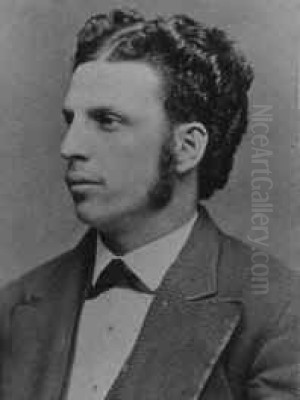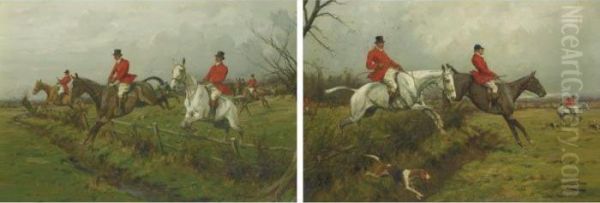
George Wright (1860-1942) stands as a significant figure in the realm of British sporting and equestrian art. Born near Leeds in West Yorkshire, England, during a time when the traditions of rural life and the excitement of the sporting field were popular subjects, Wright developed a distinct and accomplished style that captured the dynamism and elegance of horses and the activities surrounding them. His long career saw him become one of the most respected painters of his genre, leaving behind a body of work cherished by collectors and admired for its technical skill and evocative portrayal of a bygone era.
Wright hailed from an artistically inclined family. His brother, Gilbert Scott Wright (1880-1958), also became a noted artist, often collaborating with George on various projects. Another sibling, Louise Wright, was known as a craftsperson. This familial environment likely fostered George's own artistic talents from an early age, immersing him in a world where visual representation and skilled craftsmanship were valued. His focus on equestrian subjects suggests a deep familiarity and appreciation for horses, a common element in the British countryside and sporting life of the late 19th and early 20th centuries.
Early Career and Artistic Development
While specific details about his formal art education are scarce in the provided summaries, George Wright's career gained significant momentum from the 1890s onwards. A key milestone was his regular exhibition presence at the prestigious Royal Academy in London, beginning in 1892. Exhibiting at the Royal Academy was a mark of professional recognition and provided artists with a crucial platform to showcase their work to critics, patrons, and the public. This consistent presence over the years underscores the quality and appeal of his paintings within the established art world of the time.

Wright developed a particular proficiency in depicting horses, capturing their anatomy, movement, and spirit with remarkable accuracy. This skill became the cornerstone of his artistic reputation. His works often featured scenes of fox hunting, coaching inns, horse racing (particularly steeplechasing), and later, polo matches. He possessed a keen eye for detail, not only in the rendering of the animals but also in the attire of the figures, the tack, the carriages, and the surrounding landscapes.
Signature Style: Grisaille and Beyond
A distinctive feature of George Wright's early work, and one for which he remains well-known, is his use of the "grisaille" technique. Grisaille involves painting primarily or entirely in shades of grey or neutral greyish tones. This approach lends the artwork a monochromatic, almost illustrative quality, resembling detailed drawings or engravings. It is suggested that some of these grisaille works may have been intended for reproduction as illustrations in books, magazines, or popular prints, which were common formats for disseminating sporting art during that period.
While adept in grisaille, Wright did not work exclusively in monochrome. Many of his paintings utilize a full and often vibrant palette, bringing the lively scenes of the hunt or the racecourse to life with colour and light. Regardless of the technique, his paintings consistently demonstrate strong compositional skills and a narrative flair, effectively telling a story within the frame. His ability to convey the energy of a steeplechase, the camaraderie of a hunt meet, or the quiet pause at a coaching inn resonated with audiences who appreciated these aspects of British life.
Themes: Horses, Hunting, and the Dawn of the Automobile
George Wright's thematic focus remained largely consistent throughout his career, centered on the horse and its role in sport and society. Hunting scenes were a frequent subject, depicting riders and hounds in pursuit across the countryside. These paintings captured the thrill and traditions of the chase, a popular pastime among the British gentry and rural communities. Coaching scenes, often depicting elegant carriages drawn by teams of horses arriving at or departing from inns, evoked a sense of nostalgia for the pre-railway era of travel.
His work also included dynamic portrayals of horse racing, particularly steeplechasing, showcasing the speed, agility, and risk involved in the sport. After moving to Rugby in 1901, a town known for its association with sport, Wright began producing a series of polo paintings. Polo, a fast-paced equestrian sport, provided ample opportunity to depict horses and riders in complex, energetic interactions. These polo scenes became highly sought after by collectors.
Interestingly, Wright's work also documents the transition occurring in the early 20th century with the advent of the automobile. Several of his paintings depict encounters between horse-drawn vehicles or riders and early motor cars. These works serve as fascinating visual records of a time when traditional modes of transport met the new technology, sometimes with curiosity, sometimes with disruption. Titles like Horse riding to motorist (featuring a c. 1905 De Dietrich car), Snow scene with automobile and hounds (c. 1910, Maudslay car), Early car driving in rain (early 1900s, Austin car), Huntsmen meeting motor car (c. 1910, Austin car), and Two horse carriage and broken down car (c. 1903, Peugeot car) explicitly capture these moments of technological and social change.
Collaboration and Professional Recognition
George Wright's artistic career was marked by both independent work and collaboration. His partnership with his younger brother, Gilbert Scott Wright, was particularly notable. Together, they produced numerous coaching and equestrian scenes, many of which were reproduced for commercial purposes, such as calendars. This collaboration likely combined their respective strengths and increased their output and reach.
Wright's talent earned him recognition from prominent art dealers and galleries. He established a relationship with Ackermanns in London, a renowned gallery specializing in sporting art since the late 18th century. Being represented by Ackermanns was a significant endorsement of his standing in the field. Sources also mention recognition from the "Metropolitan Art Museum" by 1925, although the nature of this connection (acquisition, exhibition, or other form of recognition) requires further clarification; collaboration with Grand Central Galleries in the US is also noted in some summaries, suggesting his reputation extended across the Atlantic. His move from Rugby to London in 1908 placed him closer to the center of the British art market and major galleries.
Notable Works and Artistic Legacy
Several specific works by George Wright are frequently highlighted. Halt at the Inn (painted around 1920 but depicting an earlier, mid-to-late 19th-century scene identifiable by the docked tails of the horses) is a well-regarded example of his coaching scenes. It showcases his ability to create atmospheric settings and detailed figure work. This painting was held by the Hillstrom Museum of Art and sold at Sotheby's New York in 2013.
The Steeplechase is another title representative of his racing subjects, capturing the high-stakes drama of the race. The series depicting interactions between horses and early automobiles, as mentioned earlier, holds particular historical interest, documenting a specific moment of societal transition through the lens of sporting and rural life. Huntsman Passing a Ploughman is another example that achieved a strong price at auction.
George Wright's contribution lies in his skillful and prolific portrayal of British equestrian life during a period of significant social and technological change. His detailed observation, particularly of horses in motion, and his ability to capture the atmosphere of the hunt, the race, or the roadside inn, place him firmly within the strong tradition of British sporting art.
Context within British Sporting Art
The genre of sporting art has a long and distinguished history in Britain. George Wright's work can be seen as continuing a tradition established by earlier masters while reflecting the tastes and interests of his own time. He followed in the footsteps of giants like George Stubbs (1724-1806), renowned for his unparalleled anatomical studies of horses, and Ben Marshall (1768-1835), known for his elegant portraits of racehorses and sporting figures. The prolific John Frederick Herring Sr. (1795-1865) also set a high standard, particularly in depicting dramatic racing finishes.
Among Wright's contemporaries or near-contemporaries who also excelled in sporting and animal art were figures like Sir Alfred Munnings (1878-1959), famous for his impressionistic and vibrant depictions of horses, racing, and rural life. Lionel Edwards (1878-1966) was another highly respected artist specializing in hunting and racing scenes, known for his dynamic compositions. Cecil Aldin (1870-1935) brought a unique charm and character to his depictions of dogs, horses, and coaching scenes, often with a humorous touch.
Other relevant artists include Heywood Hardy (1842-1933), who painted genre scenes often incorporating sporting elements, and John Emms (1844-1912), particularly noted for his vigorous paintings of hounds and terriers. While focusing on wildlife, Archibald Thorburn (1860-1935) shared Wright's birth year and meticulous attention to detail in depicting game birds often found in the settings of country sports. The work of Snaffles (Charles Johnson Payne) (1884-1967) offered a more illustrative and often witty perspective on equestrian and military subjects. Looking back slightly earlier, Henry Thomas Alken (1785-1851) was a key figure known for his lively coaching, hunting, and racing prints.
Within this rich context, George Wright carved out his niche. While perhaps not as revolutionary as Stubbs or as stylistically bold as Munnings, Wright excelled in detailed, narrative depictions that were highly accomplished and commercially successful. His work captured the specific aesthetics and activities of the late Victorian and Edwardian eras, including the unique visual element of the early automobile encroaching on the horse's domain.
Later Life and Market Presence
George Wright continued to paint throughout the early decades of the 20th century, maintaining his focus on the subjects that had defined his career. He passed away in 1942, having lived through a period that saw dramatic changes in British society, technology, and art. His death occurred in Richmond, Surrey, a location he had moved to later in life.
His paintings have maintained a consistent presence in the art market, particularly at auctions specializing in British paintings or sporting art. His work appears regularly at major auction houses like Sotheby's. Records indicate respectable prices, such as the £6,400 achieved for Halt at the Inn at Sotheby's New York in 2013, and the notable £20,000 realized for Huntsman Passing a Ploughman at Sotheby's London back in 1991. Another work, A Hunting Scene, was estimated at £300-£500 in a different sale, indicating a range of values depending on size, quality, and subject matter.
The market for his work appears most active in the United Kingdom and the United States, reflecting the historical connections and enduring appeal of British sporting art in both countries. While the broader market for traditional art, including some Old Masters, has faced fluctuations, high-quality examples of British sporting art by respected artists like George Wright continue to attract collectors who appreciate the genre's historical significance, aesthetic appeal, and depiction of traditional country life. His works are found in museum collections, such as the Hillstrom Museum of Art, and undoubtedly in numerous private collections worldwide.
Conclusion
George Wright was a talented and dedicated artist who made a significant contribution to British sporting art. His meticulous rendering of horses, his evocative portrayal of hunting, coaching, and racing scenes, and his unique documentation of the early interactions between horses and automobiles define his legacy. Working alongside his brother Gilbert Scott Wright, and exhibiting regularly at the Royal Academy, he achieved considerable professional success and recognition during his lifetime. Today, his paintings are valued not only for their artistic merit and technical skill but also as vivid historical documents of British equestrian culture at the turn of the 20th century. His work continues to be sought after by collectors, ensuring his place within the enduring tradition of sporting art.